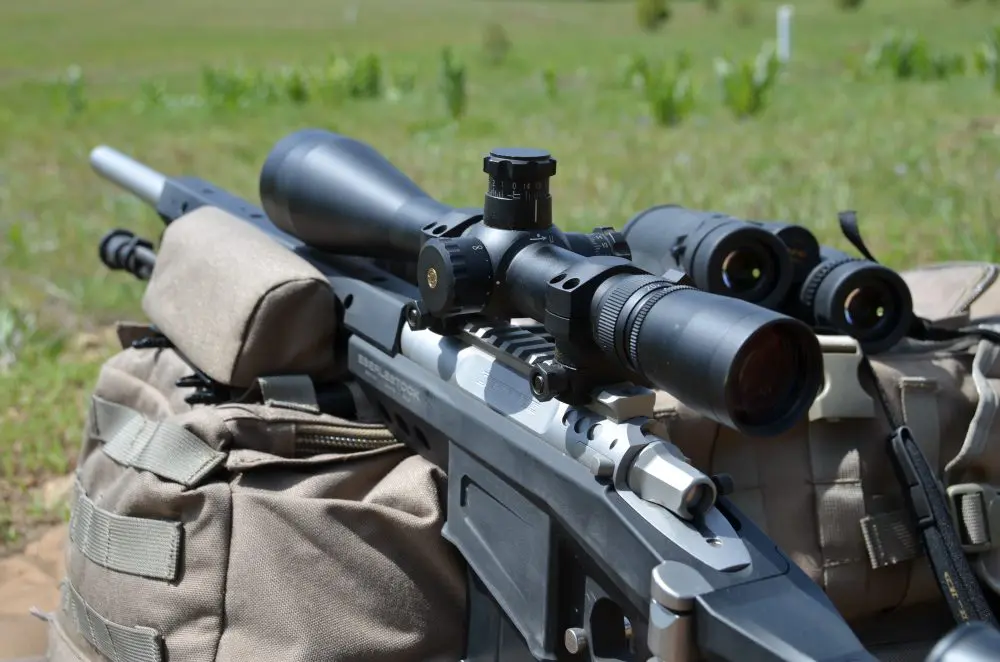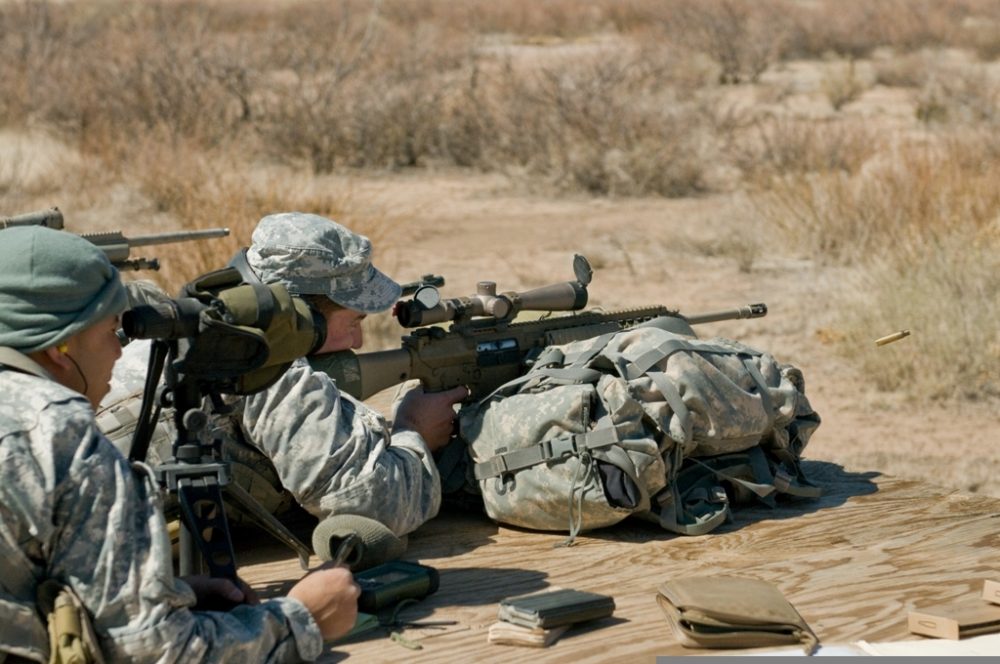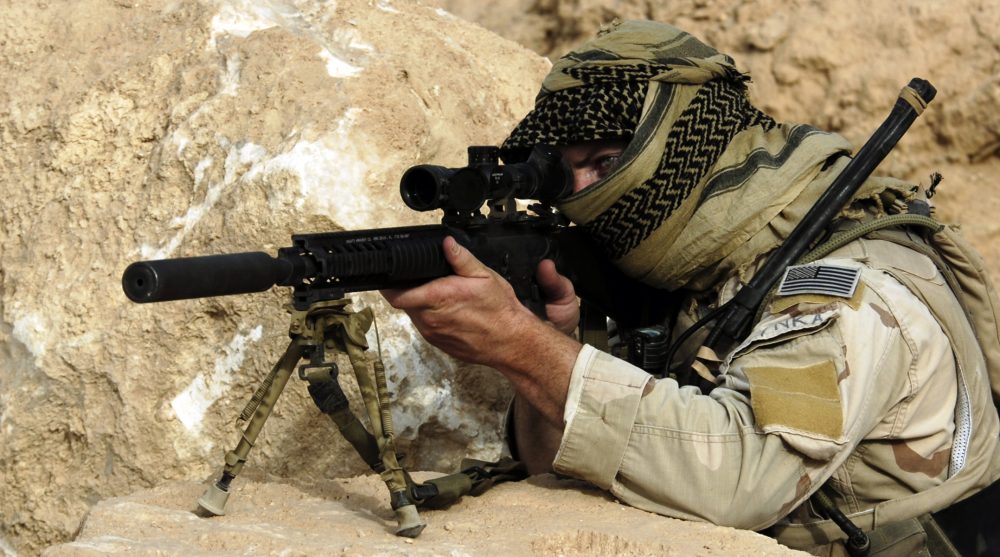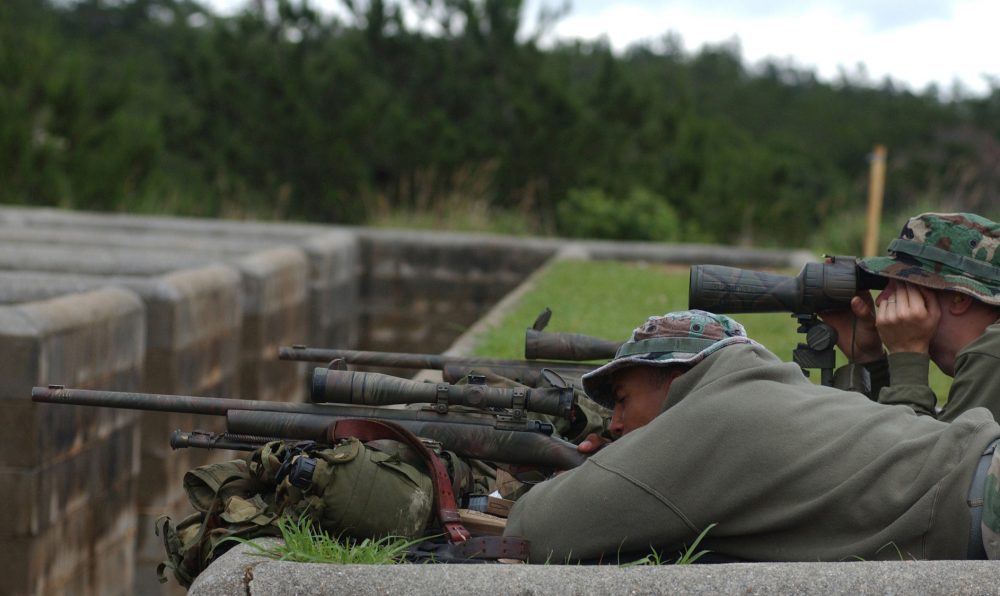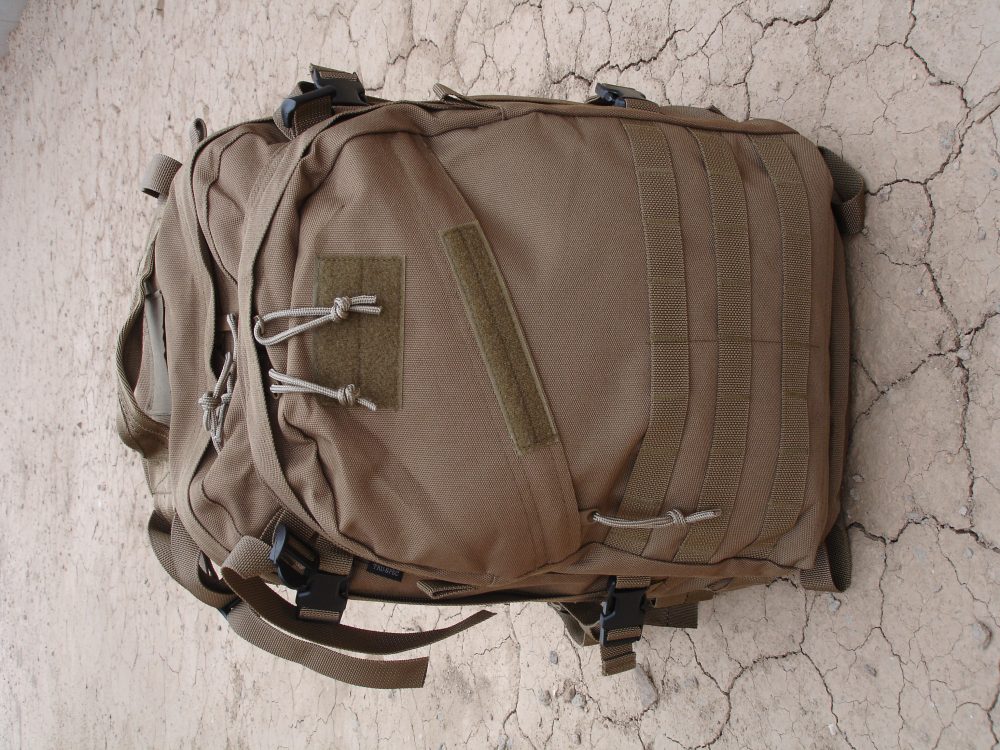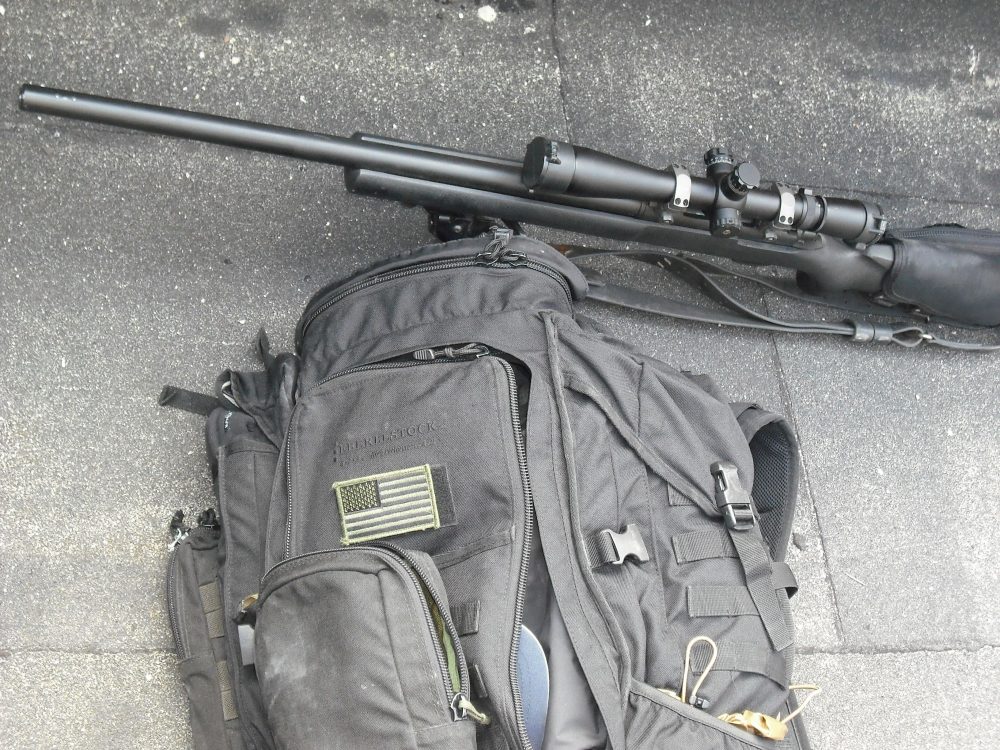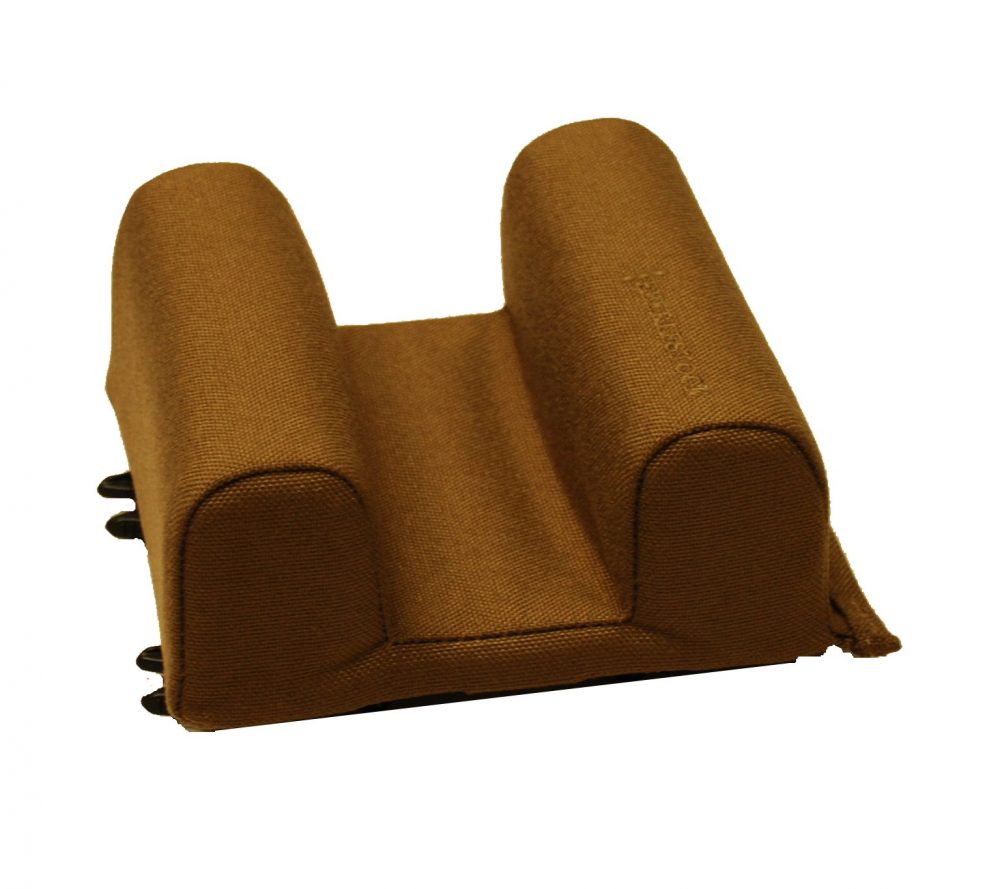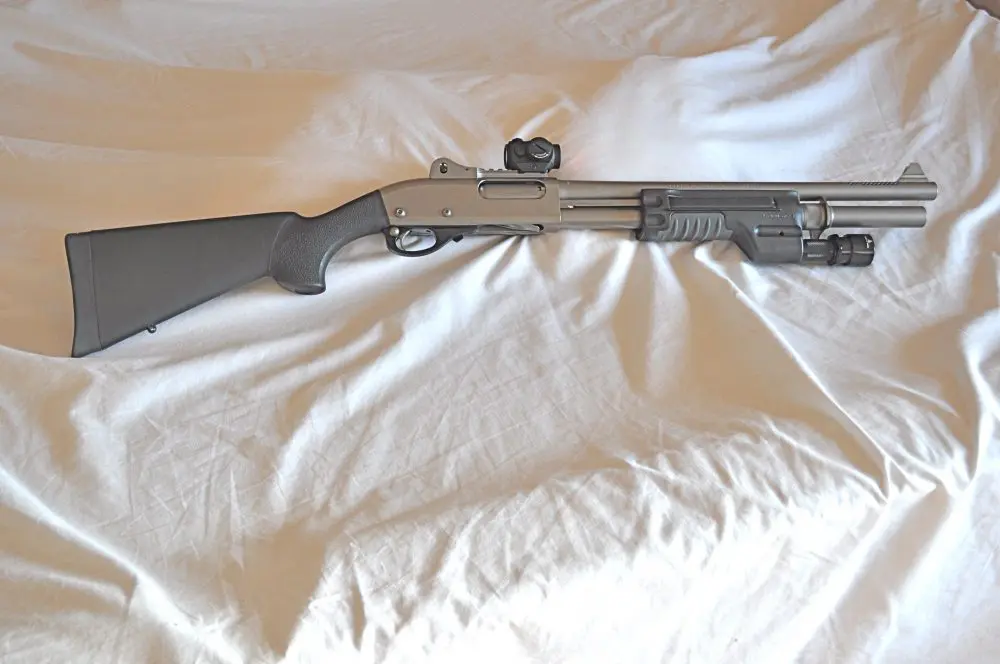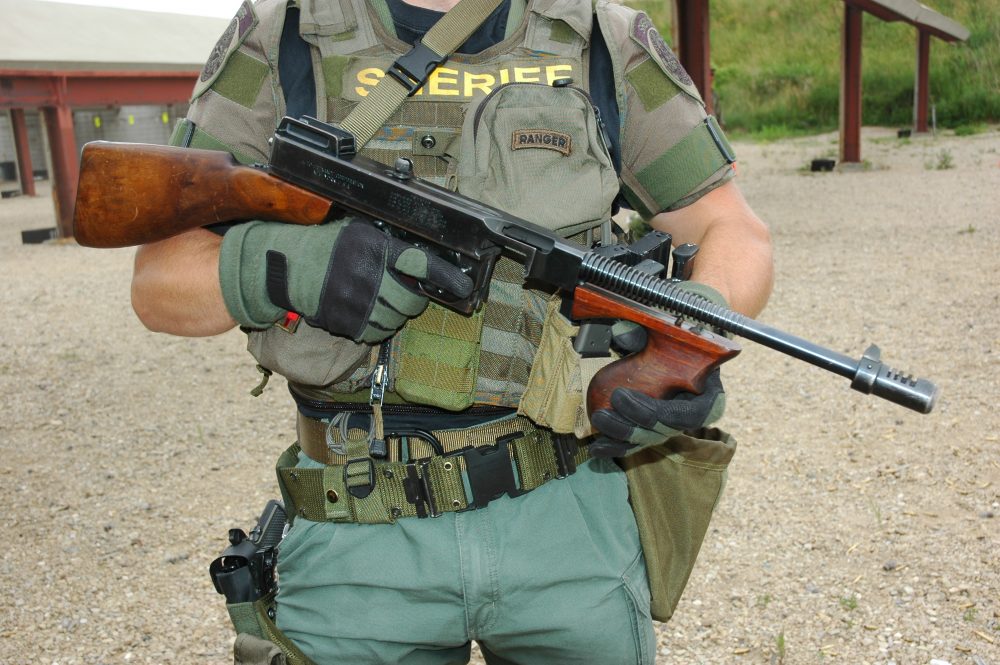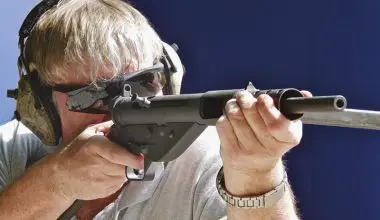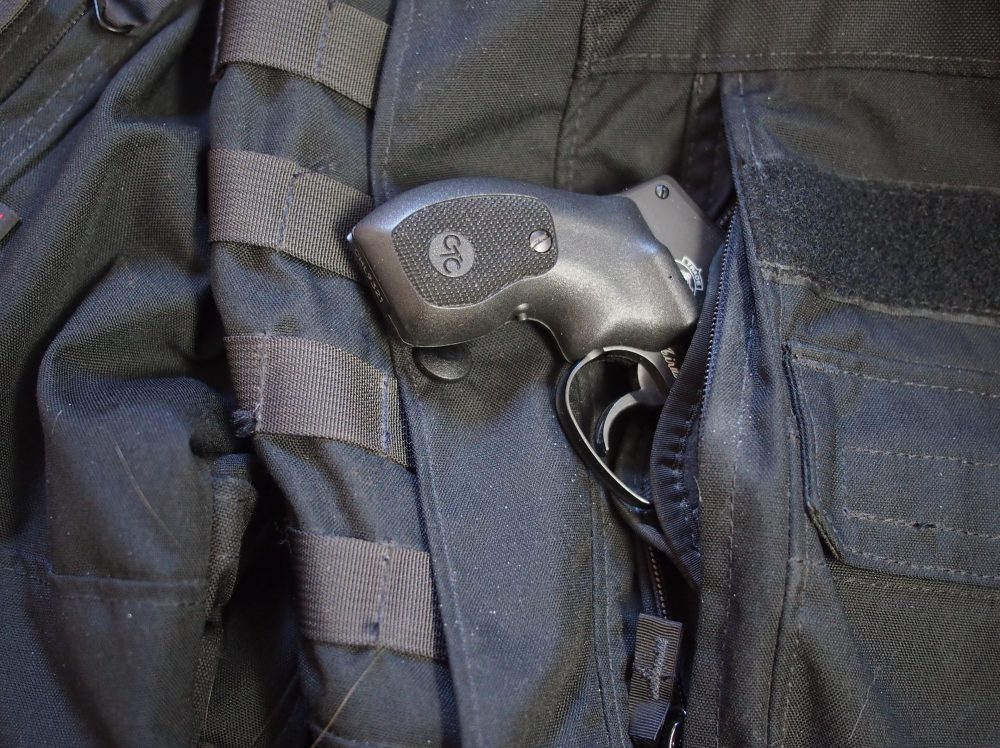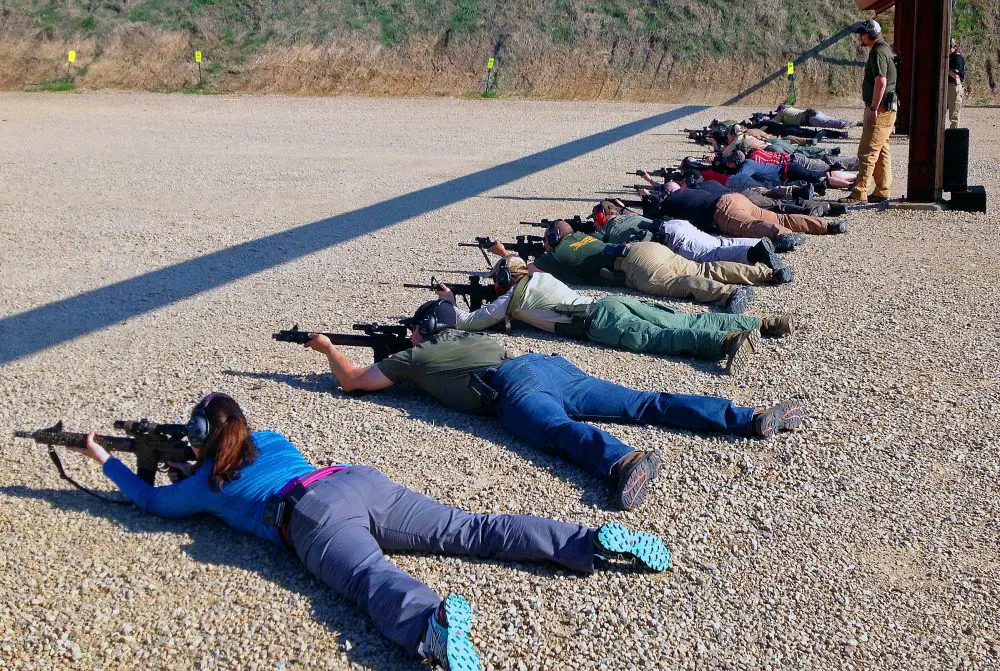As every experienced shooter knows, accurate rifle shooting requires the application of the four key fundamentals of marksmanship: steady position, sight alignment, breath control, and trigger squeeze.
When artificial support is available, it should be used to steady the position and support the rifle whenever practical. When artificial support isn’t available or practical, the bones in the shooter’s upper body must be used to provide support, along with proper use of the sling.
It should be noted that using a sling is no longer taught in many sniper classes. A sling for support is great for longer distance targets of opportunity. But for a sniper in position for long periods of time waiting for a command shot, using a sling for support isn’t practical. Of course, students attending a sniper school should have already mastered the basics, including use of a sling.
U.S. Soldier prepares to fire XM110 7.62x51mm semiautomatic sniper system off a ruck with assistance from his spotter during Army Sniper School. Shooting off the ruck is one technique taught at Sniper School. Photo: Staff Sgt. Roger RyDell Daniels
Table of Contents
VARIABLES IN PRECISION SHOOTING
Benchrest shooters are capable of phenomenal accuracy. There are three basic benchrest shooting techniques that provide tactical shooters and hunters with the foundation for more accurate field shooting. These techniques are the employment of a stable platform, the employment of a stable two-point shooting rest, and the necessity of consistent recoil.
The ground is a stable platform comparable to a benchrest shooter’s bench. Prone shooting positions are the position of choice for long-range precision shooting. A bipod is generally the front rest of choice. It provides a stable front rest and enables the firing position to be sustained for extended periods of time. Of course, many situations don’t allow us to get that close to the ground, so we need to adopt a position that gives us the same two-point support.
Free recoil in long-range precision shooting is often ignored or misunderstood. In scientific terms, free recoil is the measurement of recoil energy, i.e., translational kinetic energy. A rifle will have significant recoil before the bullet actually leaves the bore. This can affect bullet impact, which is referred to as recoil divergence. The rifle must recoil the same each time to keep bullet placement consistent.
U.S. Special Forces Soldier conducts rehearsal, training and pre-operation confirmation on MK 12 7.62x51mm semiautomatic sniper rifle equipped with Harris swivel-mount bipod. Photo: Mass Communication Specialist 2nd Class Eli J. Medellin
Point of impact can be affected if the rifle is fired from a hard surface. When a rifle is fired, the barrel resonates at certain frequencies. This is known as barrel harmonics. Any contact that’s transmitted to the barrel will have an impact on barrel harmonics and accuracy.
Using a bipod on a hard smooth surface can result in the legs shifting under recoil, which changes the point of impact and position of the rifle. By “preloading” the bipod legs with shoulder pressure prior to the shot, you can eliminate some of these issues with the smaller calibers.
Studies conducted at NSWC Crane show that while preloading works with smaller calibers, you can’t stop the movement of heavier recoiling calibers (.338 Lapua Magnum and above). A technique known as unloading is recommended when firing heavier recoiling calibers. Unloading removes the “extra space” created by preloading and forces more of the recoil to the bipod legs, slowing movement down.
U.S. Marine Corps Special Reaction Team sniper shooting M24 7.62x51mm sniper rifle off his ruck with assistance from his spotter during sniper training. Properly done, shooting off a ruck is similar to using shooting bags/sandbags as a rest. Photo: Cpl. Ryan Walker
TWO-POINT SUPPORT
The need for two-point support is also often overlooked. Ideally both the front and rear of the rifle should be supported. The rule is that the farther apart the two points of support are, the more stable the platform. A bipod or any other front rest should be employed in conjunction with a rear rest, which can be a pinch bag, rolled-up poncho, rock rest with your hand sandwiched between the rocks and the butt of the rifle, or using your offhand alone to support the butt of the rifle.
In the latter technique, your wrist bone offers support. A “V” formed by your thumb and index finger supports the butt of the rifle. The advantages of this technique are that it doesn’t require any additional equipment and will decrease the time required to take the shot.
It wasn’t until after the Vietnam War that bipods were widely used on military sniper rifles. Shooting off a rucksack (“ruck”) or backpack (the terms are interchangeable in common usage) was once taught as a primary means of front support when firing from prone. It’s still taught in most sniper schools.
Eberlestock Pack-Mountable Shooting Rest is an ultra-light backpack-mountable shooting rest that’s an alternative to shooting sticks, bipods, and hardware-based shooting rests. Photo: Eberlestock
SHOOTING OFF THE RUCK
The advent of the modern bipod hasn’t made the need to train in shooting off the ruck obsolete. Learn to use both and use what works best for you when it works best for you. There are many situations in which the use of a ruck may be preferable to the use of a bipod.
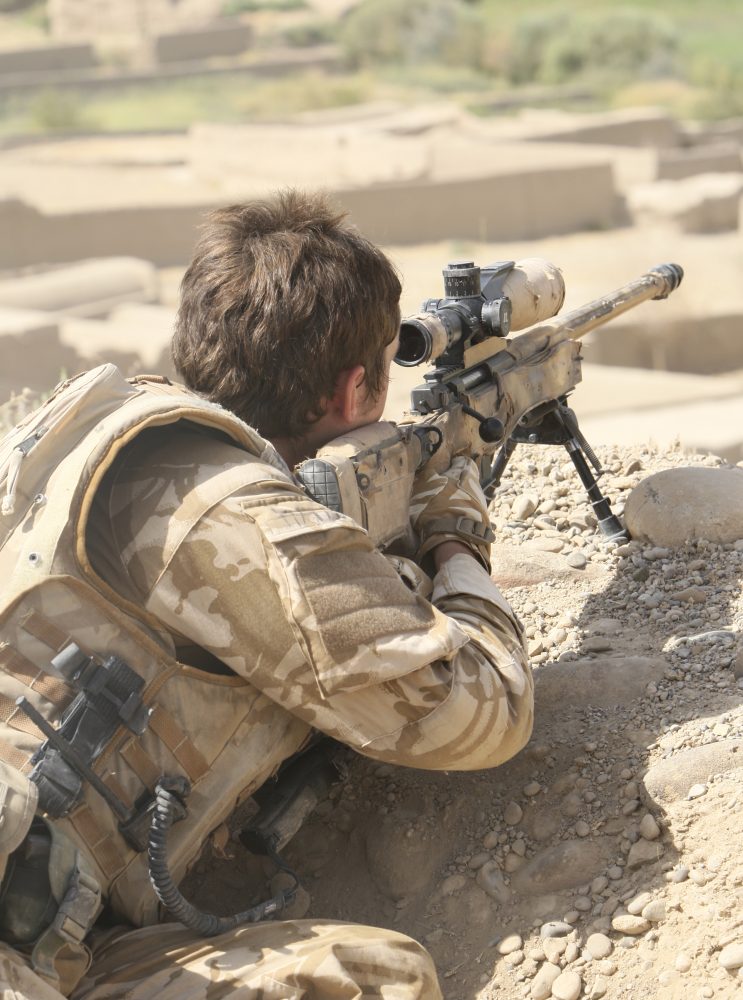
Ministry of Defence (MOD) photo is used with permission under the UK Open Government Licence (OGL).
Pluses to a bipod are that it’s always available, fairly quick to deploy, and generally provides a more stable, repeatable platform than a ruck. Any advantages in stability and consistency are surface dependant.
Pluses to a ruck are that it may be employed in many firing positions that are not amenable to the use of a bipod. Many shooters actually prefer to use a ruck as a rest and see little advantage to the bipod in stability and consistency. You can get height with a ruck beyond the capabilities of a bipod. If need be, you can stand a ruck up vertically. Although the use of a tripod or shooting sticks may be employed and in many cases is preferable, often they’re not an available option.
The use of a ruck also allows a fluidity of motion that’s not possible with many bipods, though the use of a rotating/swivel mount bipod negates this advantage to varying degrees. For example, Harris Bipods offer the Harris Rota-Pod™ rotating detachable Picatinny rail adapter for Harris bipods. This allows the bipod to pan right and left. Fluidity of motion is obviously important when tracking or switching targets.
Of course, your rifle may simply not be equipped with a bipod. Nor may equipping your rifle with a bipod be desirable given the primary application(s) for which you will be employing the weapon. If you’re out in the field, you’re likely to have with you a ruck that can be employed for zeroing or precision work.
CREATING AN EFFECTIVE PLATFORM
Shooting off a ruck is not simply a matter of plopping your rifle on it and shooting. It’s a skill and must be practiced. The ruck itself must be high enough for you to get into a comfortable shooting position behind the rifle. And most importantly, it must be stable.
The ruck must be packed so as to present a firm, stable shooting platform. We also allow fine tuning of your aim. You don’t want the ruck too soft. You also don‘t want it too hard. Properly loading any pack is a skill itself, as any backpacker will attest.
You don’t want the contents of the ruck to shift and you end up with the rifle on a hard surface. There is a tendency for the rifle to shift from recoil when firing, forcing you to reposition it when firing strings.
An expedient shooting rest can be made by filling the outer pockets or pouches with bags of dried rice, beans, or poly plastic pellets. Kitty litter is both light and inexpensive. Ziploc® bags work great for this. Some shooters make a saddle mount out of two pieces of PVC pipe padded with a piece of closed-cell foam or carpet.
If you have a ruck with an external frame, the base of the frame can also be employed as a rest. The frame should be padded to avoid any point of impact issues that would result from firing off a hard surface. Closed-cell poly foam is excellent padding material for this purpose. A strip of carpet also works.
You don’t need to spend a lot to get a good ruck. TRU-SPEC TRU-GEAR GI Spec 3-Day Backpack is perfect example.
COMMERCIAL MOLLE RESTS
Of course, the best option is simply to use a commercial MOLLE rifle rest, such as the Eberlestock Pack-Mountable Shooting Rest or Tactical Assault Gear™ MOLLE Rifle Rest. They’re a cheap addition to any MOLLE pack. MSRP for either rest is only $29.95.
They allow you to turn most any MOLLE-compatible ruck into a much more effective rifle rest. Not only are they purpose designed as a rifle rest, but the use of the MOLLE system also allows you to detach and remount the rest to various locations on your pack. This capability lets you set up a field rest with the optimal elevation for your position/location and target. You can also transfer the rest between different packs.
Assuming that you are wearing the ruck, when going prone you must of course first take it off before you can use it as a rest. This adds a little time to taking the shot. In most scenarios in which a ruck will be employed as a rest, it’s a negligible issue at most.
Eberlestock G3 Phantom next to Remington 700P Police Short Action (.308 Win) used by NYPD ESU. For its snipers, NYPD ESU chose G3 Phantom. Photo: Eberlestock
FINDING THE RIGHT RUCK
There are a lot of great rucks on the market. The selection of the appropriate ruck is dependent on mission-essential needs, including the nature and duration of operations. Other factors that need to be taken into consideration are a correct, comfortable fit and your personal preferences.
Rucks based on the military A-III style 3-Day Assault Pack are very popular. According to military lore, the A-III was originally developed for use by Naval welders to carry their tools. Naval Special Warfare operators reportedly saw its utility and adopted it. The rest is history.
The A-III pack is a mid-size frameless backpack with detachable sternum strap, padded shoulder strap with D-rings, and padded removable waist belt. It features a main compartment, interior slip pocket that can accommodate an internal frame or hydration bladder, small cargo pouch, zip closure, cargo straps/loops, and side-compression straps.
The A-III pack is primarily employed by the military for limited-duration combat operations. It’s typically used to carry sustainment gear, extra ammo, comms, etc. An A-III pack can easily take care of you for a day or two in the field.
Most pack manufacturers offer versions of the A-III pack. Features, quality and prices vary greatly. On a tight budget? You don’t need to spend a lot to get a high-quality basic ruck. An excellent example is the TRU-GEAR® GI Spec 3-Day Military Backpack from TRU-SPEC® by ATLANCO®. It’s a rugged 1,000D nylon MOLLE-compatible A-III pack. MSRP is $95.95 to $123.95, depending on color. Construction and material on the sample pack I received are top notch.
Need a larger or smaller pack or special features? Whatever your needs, there’s a pack to fill them, from BLACKHAWK!®, Maxpedition®, and Kifaru®, to name a few. All have a wide range of modular tactical packs to meet varying needs and budgets.
Eberlestock Pack-Mountable Shooting Rest was designed as lightweight alternative to bipod rest. Photo: Eberlestock
PACKS FOR SNIPER OPERATIONS
A few packs are even designed specifically for sniper operations. The Tactical Assault Gear™ Sniper Pack; Survival Corps GOPLIT Mat-Case Backpack for Sniper Rifles; and Eberlestock’s Dragonfly, Gunslinger, LoDrag™, Operator and Phantom Sniper Packs are examples. The Survival Corps GOPLIT and Eberlestock Gunslinger, LoDrag, Operator and Phantom Sniper Packs feature fixed or removable tactical scabbards. All are excellent packs.
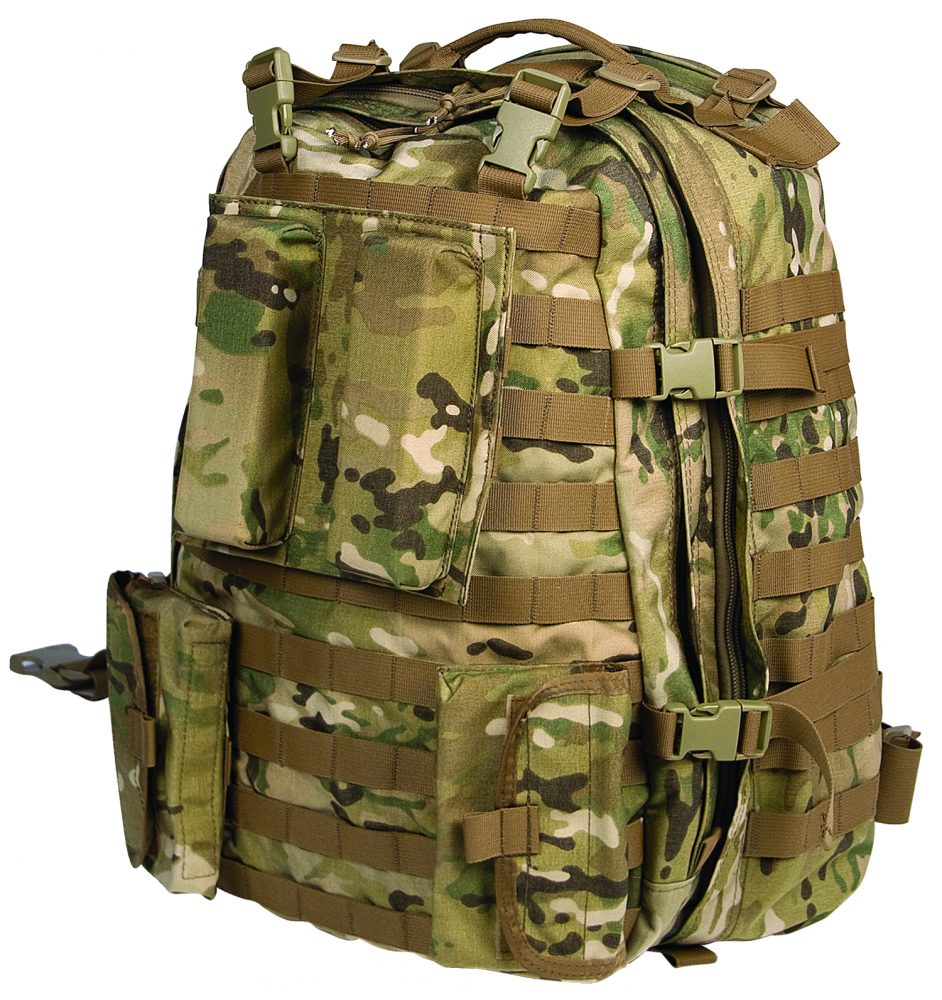
The Eberlestock G3 Phantom Sniper Pack is in use with the U.S. military. It has seen action in both Iraq and Afghanistan. The NYPD Emergency Service Unit (ESU) also chose the G3 Phantom for its snipers. It received a perfect score in NTOA testing.
The Survival Corps GOPLIT Backpack was designed for Russian anti-terrorist sniper group “ALPHA” FSB (Federal Security Service) in 2009. The ALPHA sniper team had tested “foreign analogues of similar backpacks” and wasn’t satisfied with them. Survival Corps worked with ALPHA snipers in the design of the GOPLIT. The GOPLIT is officially used by many Russian Special Forces, including FSB, Police and FSO (President Guard). It’s designed to withstand the extreme demands of mountain sniper operations. It features a rugged comfortable frame, detachable mat case for a sniper rifle, and 60-liter main backpack with two ten-liter detachable side pouches.
The Survival Corps GOPLIT Backpack has an MSRP of $605.50. The Eberlestock G3 Phantom Sniper Pack is $389.00, and the Tactical Assault Gear Sniper Pack lists for $269.99 and includes a MOLLE Rifle Rest.
Shooting off a ruck is a viable option for precision rifle shooting. It has advantages and disadvantages that need to be considered, and is a skill that needs to be practiced. It should not be ignored by today’s shooter.
SOURCES:
Blackhawk!
(800) 694-5263
www.blackhawk.com
Eberlestock
(877) 866-3047
www.eberlestock.com
Kifaru International
(800) 222-6139
www.kifaru.net
Harris Bipods
(203) 266-6906
www.harrisbipods.com
Maxpedition
(310) 768-0098
www.maxpedition.com
Survival Corps
(516) 792-1172
www.survivalcorps.com
Tactical Assault Gear
(888) 890-1199
www.tacticalassaultgearstore.com
TRU-SPEC
(800) 241-9414
www.truspec.com
